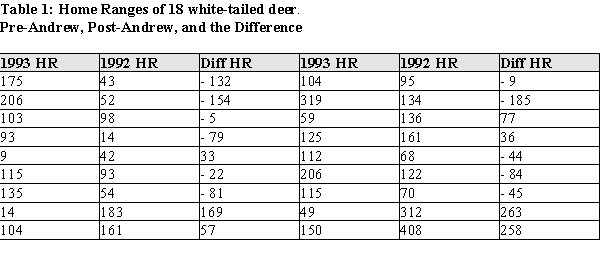Essay
In 1992 Hurricane Andrew struck Florida causing widespread devastation. The eye of Hurricane Andrew passed directly over a site where scientists were studying the ecology of white-tailed deer. The deer had been radio-collared prior to Andrew's appearance, and the hurricane provided an opportunity to study the effects of an awesome storm on the deer. The investigators felt that the home ranges of the deer would change, but were unsure of the direction of the change. (The home range is the average area an animal occupies while foraging for food and defending its territory.) Home ranges of animals usually do not change much unless an area is under ecological stress. The home range data for a random sample of 18 white-tailed radio-collared deer are shown below in Table 1. The raw area of the home range for each of the deer is reported in hectares for the pre-hurricane year of 1992 and the post hurricane year of 1993. (A hectare is a metric unit of area equal to 2.471 acres.) 
a) Using graphical display(s) of your choice show that the assumptions necessary for determining any change in the mean home ranges are plausible.
b) Construct a 95% confidence interval for the difference in means of the home ranges from before Andrew to after Andrew.
c) Do the data provide evidence of a change in the size of the home ranges after Hurricane Andrew? Provide statistical justification for your response.
Correct Answer:

Verified
a) There is no information that the de...View Answer
Unlock this answer now
Get Access to more Verified Answers free of charge
Correct Answer:
Verified
View Answer
Unlock this answer now
Get Access to more Verified Answers free of charge
Q32: A common memory task is the classification
Q33: Choose the hypotheses that can be tested
Q34: The large sample z test for μ<sub>1</sub>
Q35: The number of degrees of freedom of
Q36: The standard deviation of p<sub>1</sub> − p<sub>2</sub>
Q38: A common memory task is the classification
Q39: The Iowa Tests of Basic Skills is
Q40: A producer of instant breakfasts decides which
Q41: As part of the iguana risk assessment
Q42: For both large and small samples the